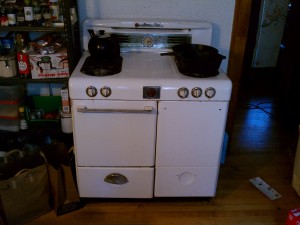Since we’re shopping for a new stove, and one feature I find attractive is a higher output burner (particularly for stir-frying), it occurred to me to check what the heat output of my existing big burner is.
Stand Back, I’m Going to do Science

My burner, on high, raised 64 fluid ounces of tap water (measured in a single large Pyrex measure) from 67°F to 130°F (by my new Taylor instant-read cooking thermometer; scale is 2 degree intervals, so the 67 is interpolated by eye) in 4 minutes (by my Casio stopwatch). I pre-heated the pan slightly, the water sizzled when I poured it in. This both accounts somewhat for the mass of the grate and the pan needing to be heated, and eliminates the need for three hands to turn on the burner, start the stopwatch, and pour in the water simultaneously.
Bowl of Plenty says I can ignore the difference between distilled water and tap water, and that water weighs 2.0803 pounds per quart.  (Yeah, “a pint’s a pound” is off by .04015 in modern measurements.)
Stove burners are rated in BTUs/hour, which they usually just call “BTUs”. Reading between the lines, they’re rated by the theoretical heat production of the volume of gas they handle. Actual heat production depends on combustion efficiency. Then there’s heat transfer to the cooking vessel. Then, in my experiment, there’s heat loss to radiation, air convection, and water evaporation. I make no attempt to account for those. Reading various online articles, people seem to think heating measured the way I did it will be about 1/2 the BTU rating of the burner.
The BTU was traditionally defined as the energy needed to raise one pound of water by 1°F at atmospheric pressure (which is about 1055 joules). (There are BTU definitions at different temperatures, which give slightly different results.)
So, 2 quarts × 2.0803 pounds/quart × ( 130 – 67) degrees = 262.1178 BTUs. 4 minutes is 1/15 of an hour, so that’s 3,932 BTUs/hour. (Yeah, I carried all the meaningless digits through to the end and then rounded.)
The rumored 2x efficiency factor from rating to reality would mean that my burner would rate a bit under 8,000 BTUs/hr.
Normal burners of modern stoves rate 8,000–12,000 BTUs/hour, so that passes sanity check.
And it also suggests that a modern stove with a burner rated at 17,000 BTUs/hr would be a LOT better for stir-frying, or for cooking pasta for that matter.
I would have felt really stupid buying a new stove with a spiffy keen high-output burner, only to discover it produced less heat than my old burner did.
So, do ya think this might have been easier in metric units? (I could have done it that way, just translating the temperatures I measured, and then translating the BTU ratings of the new stoves back to metric. But once I got done researching the definition of BTU and the density of water, it seemed like more fun to use them directly.)
Also, this is yet another example of a practical math and science problem people can encounter around their home.